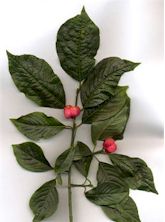|

Spindle Tree |
During the autumn, in our woody hedgerows a shrub becomes very conspicuous by bearing numerous rose-colored floral capsules, strikingly brilliant, each with a scarlet and orange-colored centre. This is the Spindle Tree (Euonymus), so called because it furnishes wood for spindles, or skewers, whence it is also named Prickwood, Skewerwood, and Gadrise, or Gad Rouge. The word "gad" is used in our western counties for a stick pointed at both ends to fasten down thatch. The
Spindle Tree has a green bark, and glossy leaves, producing only small greenish flowers: whilst the pendulous ornaments so brilliantly borne in autumn are four-lobed capsules of a pale red hue, which open out and disclose ruddy orange-colored seeds wrapped in a scarlet arillus. It is further known as the Louseberry Tree, from the fruit being applied to destroy lice in children's heads, whilst its powdered bark will kill nits, and serve to remove scurf. Other popular |
titles owned by this shrub are "gatter," "gatten," and "gatteridge." The ripe fruit, from which a medicinal tincture is prepared, furnishes euonymin, a golden resin, which is purgative and emetic. This acts specially on the liver, and promotes a free flow of bile. The plant also yields asparagin, and euonic acid. An ointment is made with the fruits: and the powdered resin is given in doses of from half-a-grain to two grains.
In the United States of America, this tree is the Wahoo, or Burning Bush. The green leaves of one species are eaten by the Arabs to induce watchfulness. In allusion to the actively irritating properties of the shrub, its name, Euonymus, is associated with that of Euonyme, the Mother of the Furies. The bark is mildly aperient and causes no nausea, whilst at the same time stimulating the liver somewhat freely. To make its decoction add an ounce to a pint of water, and
boil together slowly. A small wineglassful may be given, when cool, for a dose two or three times in the day. Of the medicinal tincture made from the bark with spirit of wine, a dose of from five to ten drops may be taken with water in the same way. French doctors call the shrub Fusain, or bonnet de pr?e (birretta). They give the fruit, three or four for a dose, as a purgative in rural districts: and employ the decoction, whilst adding some vinegar, as a lotion against
mange in horses and cattle. Also, they make from the wood when slightly charred a delicate crayon for artists.
Herb Simples
The Primitive Simplers presented here show the way of life in other generations, it is not suggested or recommended trying them yourself. |
|
Garden
Herbs
Home
History of Herbs
Herb Gardening
Herbs for Beginners
Drying & Preserving Herbs
Indoor Herb Gardening
Herb Garden
Hints & Tips
Herbal
Cooking
Herb Chart
Using Herbs
Culinary Herbs
Herb
Oil and Vinegar
Herb Teas
Herb Candy
Herb Jelly
Herb Simples
Preface
Introduction
Alphabetical Listing

Trade
Recipes Online
Share your Recipes with others!!
|


